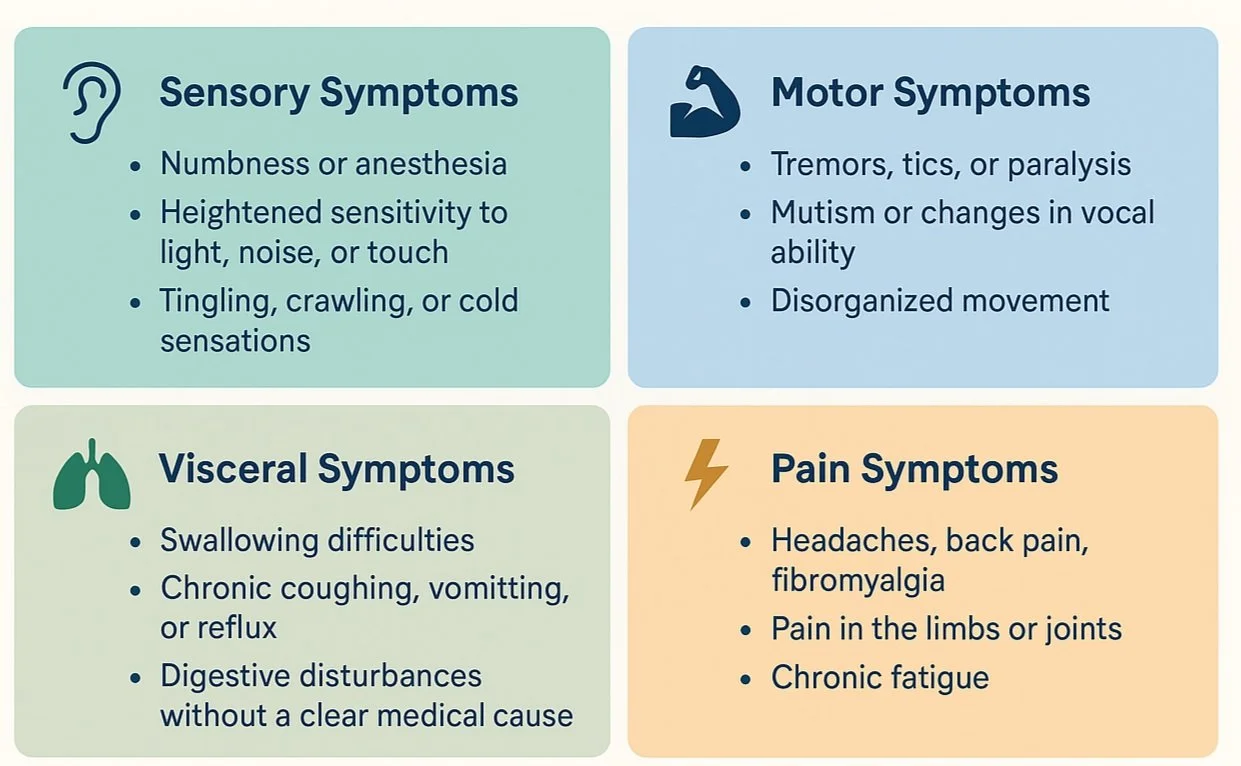When the Body Speaks: Understanding Conversion and Somatization through a Trauma-Informed Lens
Imagine living with chronic pain, mysterious neurological symptoms, or digestive issues — and every test comes back “normal.” What if these symptoms aren’t simply medical puzzles, but messages from the body trying to tell a deeper story?
In trauma-informed therapy, we understand that the body holds experiences, sometimes in ways that bypass our conscious awareness. One powerful example of this is conversion disorder, historically referred to as "hysteria" in the early 1900s. Though today it is less dramatically portrayed, its modern counterparts — chronic pain, somatization, fibromyalgia, and certain neurological symptoms — continue to affect countless individuals.
What Is Conversion Disorder and Somatization?
Conversion disorder, also known as functional neurological disorder, involves physical and neurological symptoms - such as paralysis, seizures, or speech difficulties - that cannot be explained by a medical evaluation but are very real to the individual.
Somatization disorder involves chronic physical complaints, like pain, fatigue, or gastrointestinal issues, without a clear medical cause.
These symptoms are believed to be expressions of psychological distress, serving as the body's way of communicating unresolved emotional pain. Both conditions highlight the profound connection between mind and body, emphasizing the importance of addressing psychological factors in physical health.
“Somatization is a perfect way to hide memories, especially from one’s self.”
— Janina Fisher (2009)
In other words, the body can become a container for pain the mind isn’t ready to process.
Are These Symptoms Adaptive?
From a trauma-informed, neurobiologically grounded perspective, we move away from viewing these physical symptoms as purely pathological. Instead, we ask deeper questions:
Might these symptoms act as expressions of trauma that words cannot yet access?
Could they reflect survival responses—the body's way of enduring what was once overwhelming?
Are they the nervous system’s attempt to preserve a sense of safety in the face of threat or unresolved experiences?
When understood this way, somatic symptoms are not simply signs of dysfunction. They may be intelligent adaptations, signaling what has not yet been processed or integrated. In many cases, the body carries what the mind cannot - until the conditions are safe enough for healing to begin.
What Do Somatization and Conversion Symptoms Look Like?
The Mind-Body Connection: How Trauma Manifests Physically
Trauma can disrupt the body's natural regulation, leading to physical symptoms. Research indicates that individuals with a history of trauma may experience heightened sympathetic arousal (fight or flight) or parasympathetic dominance (freeze), resulting in symptoms like muscle tension, rapid heartbeat, nausea, or dizziness .
These physiological responses can become chronic, especially when the trauma remains unprocessed, illustrating how the body "remembers" and expresses psychological wounds.
Dissociation and the Fragmented Self
When individuals cannot escape traumatic situations, the mind may employ dissociation - a defense mechanism where traumatic memories are compartmentalized. This structural dissociation can lead to parts of the self becoming disconnected, with distress manifesting through physical symptoms .
Understanding this phenomenon is crucial in trauma-informed therapy, as it underscores the need to address both psychological and physical aspects of trauma.
The Body Remembers: Trauma’s Physical Map
Different survival responses are mapped across the body:
Attach (cry for help): eyes, hands, larynx
Submit (collapse/numb): digestive system, low muscle tone
Freeze (terror): extremities
Flight: legs, feet, adrenals
Fight: jaw, shoulders, arms
These bodily responses reflect past experiences and prepare us for anticipated threats, even when there is no current danger.
A Hidden Narrative
Many individuals living with somatic symptoms are high-functioning and deeply resilient. Yet, beneath the surface, they often carry unresolved trauma.
Healing Through Trauma-Informed Therapy
Recognizing the interplay between psychological trauma and physical symptoms is vital for effective treatment. Trauma-informed therapy approaches, such as somatic experiencing, focus on restoring the mind-body connection, helping individuals process trauma and alleviate physical manifestations.
At Mind in Mind Psychology, we specialise in trauma-informed care, offering support to individuals experiencing conversion disorder, somatization, and other trauma-related conditions. Our approach emphasises compassion, understanding, and holistic healing.
Seeking Support
If you're experiencing unexplained physical symptoms and suspect they may be linked to past trauma, you're not alone. Our team at Mind in Mind Psychology is here to help you navigate your healing journey with empathy and expertise.
Contact us to learn more about our trauma-informed services and how we can support you.
References:
Fisher, J. (2009). Psychoeducational Aids for Treating Psychological Trauma.
Written by Dr. Jennifer Menon, Clinical Psychologist
BA (Psych), DipPsych, DClinPsych, MAPS



